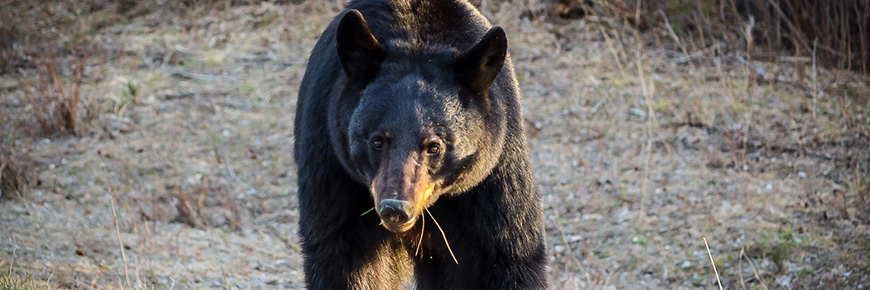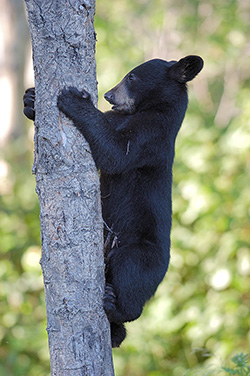
Bear smart in the park
Riding Mountain National Park
Reminder to be alert for bears in Riding Mountain National Park
Resource Conservation staff at Riding Mountain National Park (RMNP) would like to remind the public of the possibility of meeting bears in the park. The bear population has been very active lately as they take advantage of this year’s abundant berry crop. The number of encounters between bears and people has risen recently, but fortunately there has been no aggressive behaviour reported to date.
While the number of bear sightings remains high, park staff will be extra vigilant about securing wildlife attractants. Please do your part and don’t leave out food, coolers, garbage or other highly scented items. These items can catch the attention of a curious bear looking for an easy meal. Download a "Bare" Campsite brochure (PDF 4.5 MB)
Bear Safety – Q&A
Parks Canada would like to remind the public of the possibility of meeting bears in the park. When many bears and people share the same area, the chance of having a bear encounter rises. Parks Canada reminds visitors to be “Bear Smart” and remain alert when travelling to areas where bear activity has been high.

Riding Mountain National Park
Q1. How do I avoid bear encounters while visiting Riding Mountain National Park?
A1. Visitors should take the proper precautions including staying on established trails, hiking in daylight, making noise, and travelling in groups. Cyclists and runners are more at risk of sneaking up on a bear because they are quiet and fast.
Visitors and staff are reminded to:
- Be alert when in areas where bears are likely to be, such as near berry patches and other food sources. Watch for bear signs such as fresh tracks, droppings, or digging.
- Travel in groups. Keep children close by.
- Make noise. Conversation and singing will let the bear know where you are. Bears normally leave an area once they’ve sensed a human.
- Keep your dog on a leash AT ALL TIMES or leave it at home. A roaming dog might be perceived as a threat to a bear or its cubs.
- If you come across any dead animals, leave the area and report it to park staff
Q2. Where do I go for information about closures and warnings related to bears?
A2. Check the Riding Mountain National Park website (parkscanada.ca/riding) to stay up to date on wildlife-related area closures and warnings. Visitors can also obtain information about recent bear sightings and trail closures at the Visitor Centre, or by calling 204-848-7275.
Parks Canada officials may when necessary apply closures to areas deemed temporarily unsafe to protect the public. Obey all area closures – we would never close a trail or issue a warning without a good reason. It is illegal to enter a closed area.
If you are planning on using a trail with a “Warning: Bear in Area” notice, you may still use the trail, but take extra precautions to avoid an encounter. We issue warnings when there is a bear that has been using the area for an extended period of time and has been encountered by many visitors.
Q3. What should I do if I encounter a bear?
A3. Here is how to react if you encounter a black bear:
- Remain calm – speak to the bear in a low, calm voice. Do not alarm it with loud noises or sudden movement.
- Back away slowly, never run.
- Make yourself large – pick up small children and stay in a group.
- Don’t drop your backpack – it can provide protection in the event of an attack.
- Leave the area or take a detour. Do not climb a tree.
As always, if you have an encounter with wildlife please report it to RMNP staff, or if you see any illegal activity happening we ask that you please report it to Parks Canada Dispatch at 1-877-852-3100.
Q4. How can I protect my dog from bears while using the park?
A4. To prevent unsafe situations, dogs must be on a leash and under control at all times. A leash will help to keep them safe from bears, other wildlife, and other aggressive dogs. Dogs can cause stress for wildlife as they may be seen as a threat. Off-leash dogs can trigger aggressive behaviour from a bear and create a situation where they return to their human with a bear in pursuit.
Q5. What are ways campers can practice safety at the park?
A5. Parks Canada wants to remind visitors that they share the surrounding habitat with wildlife and have a responsibility to be informed and act appropriately.
Keep your picnic or camping site odour/attractant-free. Please don’t leave out food, coolers, garbage or other highly scented items. Move the food, cooler, dirty dishes, recyclables/garbage, BBQ, lotions, and pet food into your vehicle, trailer or storage locker (tents are not bear-proof). These items can catch the attention of a curious bear looking for an easy meal. Do not cook food near your tent or store food inside your tent. Put all garbage in bear-proof garbage bins.
Q6. What are the rules around roadside bear viewing?
A6. Visitors are expected to behave in a manner that is in compliance with traffic and wildlife regulations and in which they do not place others at risk. Pulling over to observe wildlife on highways can cause serious hazards.
Here are some tips to view roadside wildlife safety:
- Drive by slowly instead of stopping. This is the best way to minimize your impact on a roadside bear.
- Warn other motorists by flashing your hazard lights.
- Be extra cautious as sight lines are often blocked by improperly parked cars.
- Be on the lookout for distracted drivers, people crossing the highway, or the possibility of a bear darting out in front of you.
If you decide to stay:
- Pull over safely without blocking the driving lane (ideally at a pull-off).
- Observe and photograph bears from the safety of your car.
- View from afar. Please ensure that you are not crowding, approaching or obstructing a bear’s pathway.
- Do not feed or use attractants to entice the bear to come closer.
Give bears space: Visitors often do not realize that their enthusiasm and excitement to take pictures and to view a bear in the wild causes them to get too close or to crowd these sensitive animals. The repeated impact of people getting too close to bears also causes them to lose their natural fear of humans. Bears that become comfortable around people and facilities are at a greater risk of being struck by vehicles or finding improperly stored food and garbage by negligent park users. Please do your part by viewing bears responsibly.
Q7. It seems like there are a lot more bears than usual this year! What’s up with that?
A7. We do not believe there has been any change in bear populations. Visitors should expect to see bears when they use trails in Riding Mountain National Park. The berries are in season right now and berry bushes along the sides of trails will attract bears. Be alert and keep an eye out for bear signs such as fresh tracks, droppings, or digging.
We estimate there are 800-1000 bears in RMNP. It is hard to estimate the exact number of bears in RMNP through traditional methods of counting. Bears are out of the dens in the summer when they would be countable. Doing traditional counts, from the air, is not possible due to leaf cover and the fact that bears blend into the surroundings so well. We currently use an estimate based on the available habitat types and use methods from other jurisdictions that have done the work to determine the population.
Q8. Is there a certain time of year when bears are more aggressive?
A8. Not particularly. Bears may react aggressively if they are surprised or caught off guard.
A bear’s natural avoidance behaviour can shift to aggression if they are protecting their young or a food source, your dog provokes them, or if they feel trapped.
When bears get surprised, especially females with cubs, they may have different reactions:
- They might make a woofing noise, clack their jaw, or stamp on the ground
- They may bluff charge, coming within feet of you and then veering away at the last second
Q9. What do I do if I see an injured bear?
A9. Do not approach the bear. Visitors should report any sightings of injured wildlife to Parks Canada Dispatch at 1-877-852-3100.
Q10. What can I do to help protect bears?
A10. The best thing you can do for bears is to limit their exposure to you.
- Consider not stopping when you see a roadside bear.
- Put all garbage in bear-proof garbage bins.
- Keep your picnic or camping site odour/attractant-free. Move the food, cooler, dirty dishes, recyclables/garbage, BBQ, lotions, and pet food into your vehicle, trailer or storage locker (tents are not bear-proof).
- Use official trails only and leave the wild trails to wildlife.
- Respect closures and group access requirements—they are in place for your safety and to give bears a chance to use critical habitat undisturbed.
- Pay attention to warnings—follow recommendations. Be careful when travelling through these areas, or choose a different route.
- Date modified :